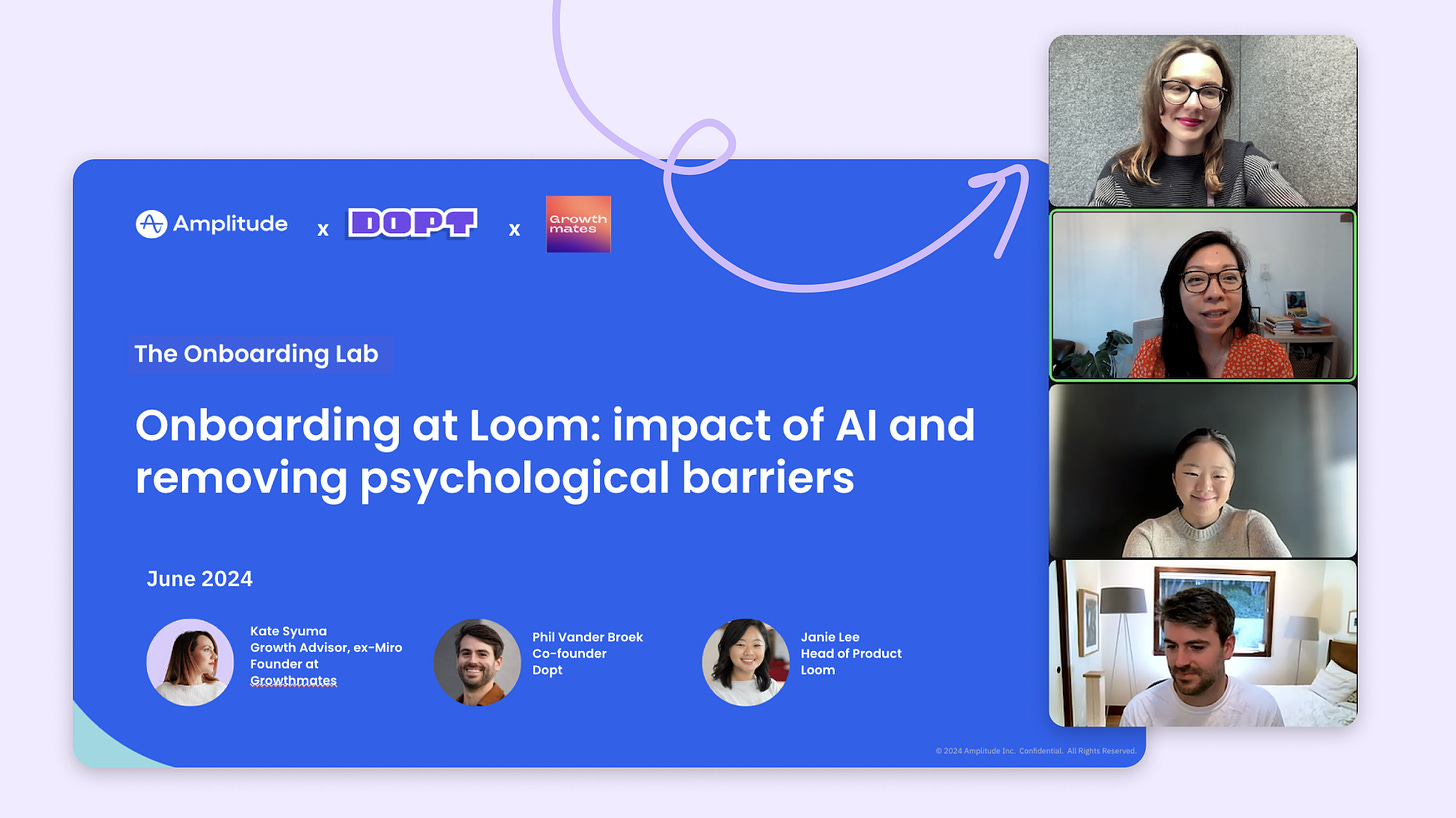Onboarding at Loom: The impact of AI and Removing Psychological barriers
2 case studies from Head of Product at Loom to drive Activation and Sharing.
A couple of months ago (in June 2024) I had the pleasure of being invited by Amplitude to facilitate “Onboarding Lab” sessions and Growth leaders from Loom, Reforge, and Superhuman (special thanks to
for co-hosting 🙌)Looking back, I realized that these stories we so valuable, that I asked all participants if they were open to sharing them with a broader community through this newsletter, and they said yes.
In this newsletter, I’d like to share a deep dive into each of these stories:
Onboarding at Loom: The impact of AI and removing psychological barriers with Janie Lee (today’s issue ⚡️)
Onboarding at Reforge: The Power of Simplicity with Gianna Sen-Gupta (coming soon)
Onboarding at Superhuman: Which Experiments Moved the Needle with
(coming soon)
If you'd like to receive stories like this right in your inbox — subscribe to this newsletter and check it in the coming months for more stories like this.
Today we will start exploring Loom story, and you will learn:
What’s Activation at Loom.
How AI helped to improve the experience for Creators and Viewers.
How to remove Psychological barriers to drive Sharing.
Summary and Key Takeaways that you can apply.
So now, let’s dive in 👇
Brought to you by Command.ai — a user-focused platform offering an alternative to traditional popups or chatbots. Their AI “Copilot” answers questions, performs actions, and simplifies complex tasks. Use “Nudges” to guide users with timely, relevant messages, all within a no-code platform. Perfect for Product, Support, and Marketing teams to positively influence user behavior while respecting their needs:
Onboarding at Loom: The impact of AI and removing psychological barriers
I met Janie on the Growthmates podcast where we discussed how they build Growth team culture, Growth <> Core collaboration, and more hot topics like these. After recording this episode, it was a no-brainer to invite Janie to participate in this Onboarding Lab series to learn more about their approach on User Onboarding.
Loom has been making waves since it was founded in 2017, and was acquired in 2023. So, what makes this tool stand out in the crowded world of workplace communication? Let’s break it down:
Loom was founded in 2017 (and acquired in 2023 by Atlassian);
Its mission is empowering effective communication at work through video messaging;
Serving a global workforce with 25+ million users in over 120 countries;
Trusted by 350,000 companies worldwide.
One of the essential components that led to that success was the focus on user experience starting from the very first interaction with the product. As we know — this is all connected to User Onboarding and Activation.
What is Activation at Loom?
At Loom, the activation metric is defined by a key user behavior: the Video First View (VFV). A user is considered "activated" when they create and share their first video, and that video receives at least one view within the first week. This metric focuses on ensuring that creators not only record a video but also successfully share it in a way that leads to meaningful engagement, signified by someone watching the video.
1 VFV (Video First View) = One recording with at least 1 view in Week 1.
If you’re still trying to define the Activation metic for your product — here’s a quick reminder for you. Define your Habit moment, Aha moment, and Setup moment (yes, in that order). It will help you connect your Activation metric to longer-term Retention and Monetisation from the beginning.
Find more valuable frameworks like this in “The Holistic Growth Playbook” by Groathmetes.
Case Study #1: How Loom Added value to the first experience with AI
Imagine spending time recording a video, hitting send, and then… crickets. No one watches it. It’s discouraging, right? This was the reality for many new Loom creators. While they embraced the ease of recording, they often skipped adding titles or any context, leading to a big problem: viewers received a video link with no idea what it was about. Unsurprisingly, this lack of context resulted in a significant drop-off between creators sharing their videos and those videos being viewed.
For the team at Loom, this was a major hurdle in driving activation rates — new creators weren’t seeing their videos engaged with, making it harder to onboard them successfully. The challenge? How do you ensure videos get viewed without adding extra friction to the creator’s workflow?
🔴 Before → Missing context leads to lost Engagement.
To summarise, Loom experienced 2 problems:
For Creators: New creators were sharing videos without adding titles or any context. While they preferred the ease and simplicity of recording and sending videos, the lack of clear information meant their videos often went unwatched. This drop in engagement left creators discouraged, as their hard work failed to generate meaningful interactions.
For Viewers: Viewers received videos with no explanation of what the content was about, making it hard to determine if the video was worth their time. Without titles or summaries, videos felt unclear and irrelevant, leading viewers to skip them entirely, further contributing to the drop in activation rates.
🟢 After → Adding valuable context with AI.
Keep reading with a 7-day free trial
Subscribe to Growthmates with Kate Syuma to keep reading this post and get 7 days of free access to the full post archives.











